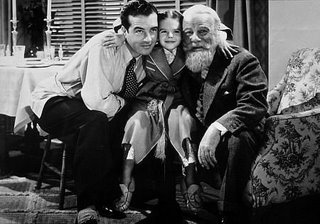
National Lampoon's Christmas Vacation
A petty-bourgeois patriarch obsessed with lighting (Clark) is shocked when a distantly related serf (Eddie) upends class distinctions. For years, the now-itinerant serf and his family relied on a worm farm as their sole means of livelihood. Now the serf is so destitute that he disposes feces into a common drainage system.
Yet the petty-bourgeois partriarch is, himself, forced to confront the exploitation of labor when a great industrial capitalist refuses to grant him full payment for work, therein attacking the labor theory of value. In a gesture intended to ignite revolution and assume control of the means of production, the serf violently kidnaps the great industrial capitalist.
The industrial capitalist recants and agrees to more equitable distribution of wealth, which the petty-bourgeois partriarch plans to waste on a swimming pool.
A Christmas Story
A young boy (Ralphie) grows up a son of the manufacturing middle class, yet behaves as the wholesale agent of capital. He singlemindedly pursues the acquisition of a firearm -- most likely as a utility for control over the proletariat -- and exploits others for his own amusement, specifically when he encourages a child to destroy his tongue on a flagpole. Later, when confronted by an outraged member of the proletariat (Scott Farkas) the agent of capital unleashes violence and profanity, thus discouraging proletarian children from rebelling.
Yet as he gradually accumulates personal property -- including a bunny suit and a fraudulent decoder ring -- the agent of capital begins to recognize that transitioning into the petty-bourgeoisie will come at the cost of dignity and personhood. He brandishes the cherished firearm and is promptly injured in its discharge; thereafter, a pack of feral dogs destroy the humble meal of the manufacturing middle class.
At the film's conclusion, we are left to wonder whether the agent of capital will continue to climb into the petty bourgeoisie, or, alternatively, whether he will assume a place in the revolutionary class.
Miracle on 34th Street

A cautionary tale in which capital exploits a mentally ill old man (Kris Kringle) in order to perpetrate its control of the means of production while simultaneously indoctrinating the young into a syndicate of hegemony. Capital enslaves an elderly man and attributes mystical powers to him. In return, the old man tells parents to buy toys for their children. Appeasing his masters, a corrupt judge refuses to imprison the blatantly disturbed man. At the film's conclusion, at least one child (Susan) is brainwashed and two individual bourgeois manufacturers celebrate by purchasing an estate.
It's a Wonderful Life
Petty Bourgeoisie.
A tale intended to inspire the proletariat and lower strata of the middle class -- which is, paradoxically, premised on transfer of wealth from the exploited to a member of the petty-bourgeoisie.
As with most populated regions, a great industrial capitalist (Mr. Potter) exercises tyrannical control over the village of Bedford Falls. In order to maintain shelter, the lower strata of the middle class and the proletarians rely upon an ineffectual benefactor (George Bailey). When the great industrial capitalist robs Bailey of his funds, Bailey experiences a series of false religious hallucinations, which dissuade him from suicide.
The proletarians and the lower strata of the middle class then shower Bailey with money -- tellingly, so does a distant industrialist who perpetrates the means of control. The film offers false hope to the struggling masses insofar as shelter is concerned. As Marx himself wrote, "No sooner is the exploitation of the laborer by the manufacturer, so far at an end, that he receives his wages in cash, than he is set upon by the other portion of the bourgeoisie, the landlord, the shopkeeper, the pawnbroker, etc."
A better film would have concluded with the proletarians destitute and starving, therein speeding labor's conflict with capital and hastening the inevitable revolution.
'Twas the Night Before Christmas

A story where eight tiny reindeer represent a proletariat that lives only so long as it finds work. St. Nick represents the slavery of machine capital, and the narrator and his family represent bourgeois values.
Shortly after the poem concludes, Dasher, Dancer, Prancer, Vixen, Comet, Cupid, Donner and Blitzen reject inequitable divisions of labor and demand that St. Nick pull the sleigh. He can't fly, and the nine perish when they crash into a garment factory manned by child laborers.






5 comments:
I can't believe you left "Santa Clause 3" off this list.
What about Bad Santa?
1.) I haven't seen either movie, but 2.) you guys are playing loose with the definition of what's a classic, and 3.) there are only so many terms you can throw around from a junior-year history seminar before the concept gets old -- if it didn't by the third movie.
Bad Santa is most definitely a classic. Badder Santa is not.
merry christmas, crimenotes and flop. i will pine for you in l.a. ...
Post a Comment